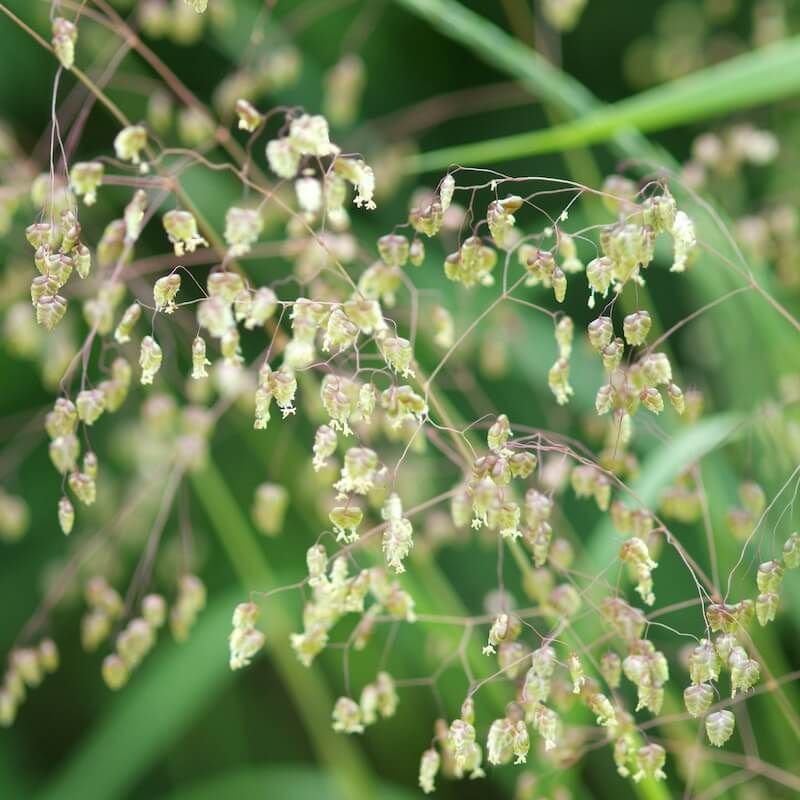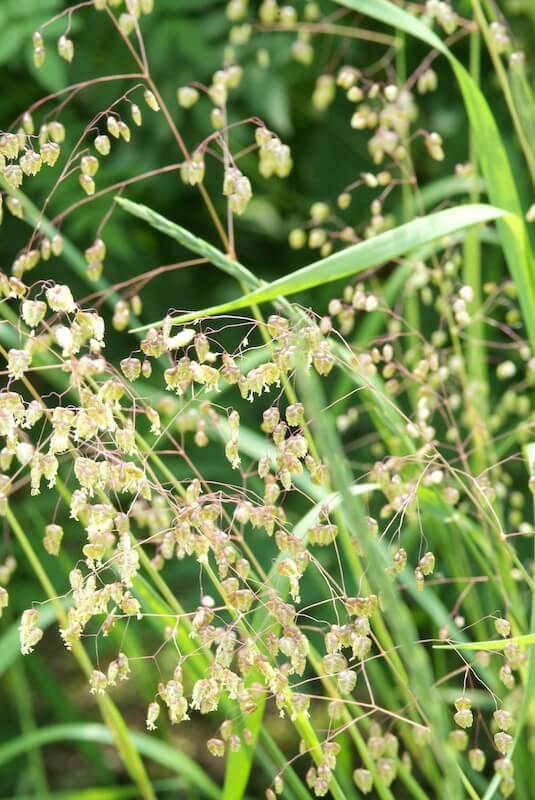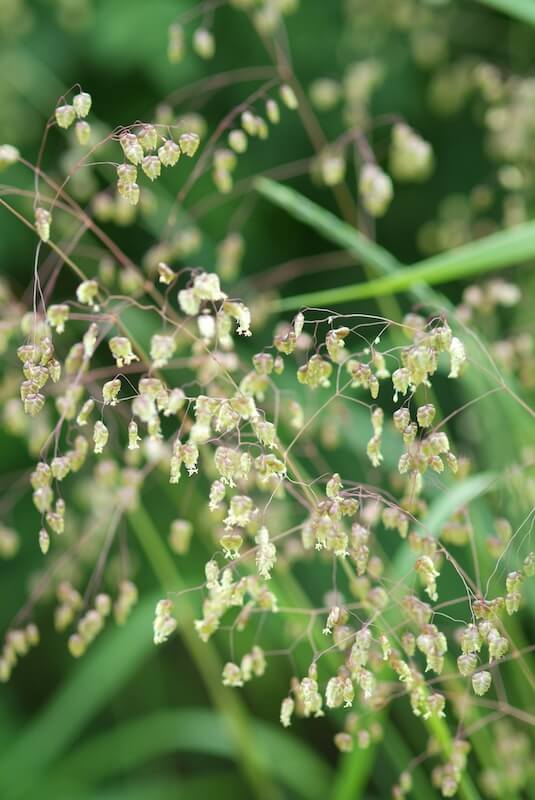Growing Briza media - The Charming Quaking Grass for Your Garden
common quaking grass, cow quake, didder, dithering grass, dodder grass, doddering dillies, doddle grass, earthquakes, jiggle-joggles, jockey grass, lady’s hair, maidenhair grass, pearl grass, quake grass, quakers and shakers, shaking grass, totter, wagwants, crydwellt, Briza media f. microstachya

Position
- Prefers full sun but tolerates light afternoon shade
- Ideal for gravel or prairie-style borders, meadow plantings and naturalistic schemes
- Avoid heavy shade to ensure good flowering and seed-head display
Hardiness
- Survives winter lows down to about –20 °C (–4 °F)
- Reliable across the UK; a light mulch in very exposed sites adds extra protection
Soil
- Thrives in well-drained, moderately fertile soil
- Performs well in poor or stony soils, especially with sharp sand or grit for improvement
- Avoids heavy clay or waterlogged conditions
- Suited to neutral or alkaline soils; tolerates mildly acid conditions
- Best where organic matter helps maintain a free-draining structure
- Grab a soil test kit and ensure the perfect conditions for growth
Height
- Typically reaches 40–60 cm (16–24 in) tall
Seasons of Interest
- Foliage: Fine, bright green leaves from spring through autumn, providing subtle texture
- Flowering: Delicate, nodding panicles (“quaking” seed heads) from June to July, offering gentle movement in the breeze
- Autumn Colour: By late summer and autumn, foliage and spent stems age to golden-yellow and light brown before dying back; no variegation
Additional Notes
- Self-seeds readily; remove spent seed heads if unwanted seedlings appear
- Cut back to ground level in late autumn or early spring to encourage fresh, compact growth
- Drought-tolerant once established—ideal for low-maintenance or drought-prone areas
- Excellent for dried flower arrangements and for adding movement to mixed plantings
- Divide large clumps in early spring if overcrowding occurs, though division is rarely needed
Briza media - A Delicate Ornamental Grass with Stunning Seedheads
Briza media, also known as quaking grass or common quaking grass, is a truly special addition to the ornamental garden. With its heart-shaped flowerheads, delicate movement, and distinctive form, it brings elegance and texture to borders, meadows, and naturalistic plantings. A native perennial grass, it’s also wonderfully low maintenance, drought-tolerant once established, and suitable for a wide range of UK gardens.
What makes Briza media such a distinctive grass?
Briza media stands out thanks to its graceful form, nodding flowerheads, and slow-growing, clump-forming habit. The airy panicles of heart-shaped spikelets hang from slender, upright stems, and nod charmingly in the breeze — hence its common names, quaking grass, quaking-grass, and even doddering dillies in some regions of the UK.
This ornamental perennial grass typically grows to a height of around 30–60cm. The blue-green leaves provide a soft, finely textured foliage base throughout much of the year. As the flowerheads mature from fresh green to buff and eventually fade into winter, they continue to offer visual interest, both in the garden and as a dried flower.
Its distinctive appearance and elegant movement make it an excellent addition to border plantings and meadow schemes. It’s one of those grasses that quietly elevates the whole composition without overwhelming the scene.
Is Briza media easy to grow from seed?
Yes, Briza media is straightforward to grow from seed, though it does take a little patience. Sow grass seeds in spring or early autumn, ideally in trays filled with a light, well-drained compost mix. Lightly press the seed into the surface without covering it, as light aids germination.
Germination can take several weeks, so keep the soil moist but never waterlogged. Once seedlings appear, allow them to grow until they are large enough to handle, then transplant them into individual pots or directly into the garden.
Once established, this perennial needs little extra care. With its drought-tolerant, once-established nature, it’s a fantastic choice for dry gardens, wildflower meadows, and areas with poor soil, as long as drainage is good.

What are the best conditions for planting Briza media?
To thrive, Briza media needs well-drained soil and a location in full sun or light shade. It tolerates a wide range of soil types — including sandy, chalky, or loamy soils — but prefers a neutral to slightly alkaline pH.
Choose a site with plenty of sunlight for the best flowering performance. While the grass is semi-evergreen, flowering is most abundant when grown in full sun. In shade, the flowerheads tend to be fewer and less striking.
Once planted, give the grass time to settle and establish. Avoid heavy mulching around the tuft, as this may retain too much moisture and lead to rot. With the right conditions, you’ll enjoy years of gently nodding flowerheads.
When does common quaking grass flower?
Briza media, or common quaking grass, blooms from late spring through early summer, often continuing into June to September depending on location and weather. The flowerheads first appear green, turning buff and occasionally tinged with purple as the season progresses.
These airy, dangling spikelets create a striking contrast against other plants, especially when caught in a light breeze. The movement they bring is subtle but noticeable — a feature that many gardeners find irresistibly attractive.
After flowering, the seedheads remain on the stem, gradually fading into foliage in winter. They can be left standing to add structure during the colder months or collected for use in dried flower arrangements.
How does Briza media perform in winter?
This perennial grass is semi-evergreen, meaning it may retain some foliage over winter, especially in milder parts of the UK. The leaves fade to grey-green, creating a subtle backdrop in the winter garden.
In late winter, you can cut back any tired foliage to make way for fresh spring growth. This rejuvenates the plant and helps maintain a tidy, vigorous clump. Take care not to cut into the crown, particularly if the weather remains cold.
While Briza media is hardy, it may appreciate a mulch of dry leaves or compost in very cold areas, especially if young. Mature plants are resilient and thrive year after year with very little fuss.
How can I use quaking grass in garden design?
Quaking grass is incredibly versatile in garden design. Use it in borders to introduce fine texture and graceful movement, or blend it into wildflower plantings where it weaves naturally among other species.
Its delicate form pairs beautifully with flowering perennials, particularly those with upright stems or larger, bolder flower shapes. Think of companions like Salvia, Achillea, or Echinacea to contrast its slender silhouette.
It’s also perfect for meadow areas and informal grassland designs, where it adds rhythm and soft visual interest throughout the seasons. Whether in a naturalistic setting or a more structured layout, Briza media brings an understated charm that enhances everything around it.
Does Briza media self-seed in the garden?
Yes, Briza media can self-seed, especially if left undisturbed after flowering. The seedheads ripen over summer and drop naturally, allowing new plants to appear the following spring.
While self-seeding is generally welcome in meadow areas or naturalistic plantings, you may wish to control it in more formal beds. If so, simply cut off the seedheads before they mature fully.
Collecting seed is easy. Wait until the heads have dried on the stem, then shake gently into a paper bag. Store grass seeds in a cool, dry place and sow in the following spring for best results.
What maintenance does Briza media require?
Once established, Briza media is a low-maintenance grass. It needs little more than an annual tidy-up in late winter to remove faded leaves and old flower stems. This promotes healthy new growth in spring.
Avoid feeding with high-nitrogen fertilisers, as this encourages soft, floppy growth. Instead, focus on maintaining well-drained soil conditions and occasional watering in prolonged dry spells.
This ornamental grass rarely suffers from pests or diseases. It is an ideal choice for gardeners looking for beauty with minimal effort, and its performance improves with age as the tuft slowly expands.
Is Briza media good for wildlife or eco-gardening?
Yes, Briza media has excellent value in wildflower gardens and eco-friendly plantings. As a native UK grass, it supports insect life and contributes to local biodiversity. Its airy structure allows light through to lower-growing plants, supporting layered planting schemes.
The seedheads provide food for birds in winter, while the gently swaying flowerheads offer shelter for small insects and beneficial pollinators during the growing season.
In a naturalised meadow or grassland, Briza media blends beautifully with native species, helping to create healthy and resilient garden ecosystems. It’s a small plant with a big role in sustainable gardening.
Can Briza media be used as a dried flower?
Absolutely. The unique heart-shaped flowerheads of Briza media make excellent additions to dried flower arrangements. Harvest them when the flower heads have turned from green to pale buff, but before they drop their seed.
Tie small bunches and hang them upside down in a cool, dark, well-ventilated place for two to three weeks. Once dried, they retain their form and delicate appearance, lasting for months indoors.
These preserved stems add a natural, textured element to floral crafts, wreaths, and minimalist displays. Whether in the garden or the vase, this grass delivers enduring beauty.
From Darren’s Patch
I’ve always admired how Briza media introduces the most delicate movement to the garden—those gentle, nodding flowerheads feel almost like a living whisper among more robust plants. While I’m not growing it in my plot just yet, I’ve watched it dance through borders and meadows in the neighbourhood and longed to introduce that texture to my own space. I’d highly recommend sowing it from seed in a light, well-drained soil—there’s something incredibly rewarding about nurturing those first slender shoots. And once established, it quietly rewards you all season long with minimal fuss. I’m looking forward to finding the perfect spot here in my garden to let this graceful quaking grass shine.
![]()
Key Points to Remember
- Briza media, or quaking grass, is a native, semi-evergreen perennial grass with distinctive heart-shaped flowerheads
- It thrives in full sun or sun and light shade, in well-drained soil and poor conditions once established
- Flowers appear from late spring through early summer, swaying gently in the breeze for added movement and texture
- Sow seed in spring or autumn, and allow space for the clump-forming habit to develop over time
- Cut back in late winter to make room for fresh spring growth
- Suitable for borders, meadows, wildflower plantings, or grassland gardens
- Drought-tolerant once established and ideal for low-maintenance gardening
- A brilliant choice for dried flower arrangements and wildlife-friendly landscapes
- Natural self-seeding helps it spread gently in informal or naturalistic designs
- Pairs well with other ornamental grasses and summer flowers for layered, year-round interest
Briza media brings quiet structure, texture, and gentle movement to any outdoor space. Whether you’re building a wildflower meadow or styling a refined border, this grass offers lasting charm through every season.
Check out the RHS article here.
If you like this one, you’ll love Hakonechloa Mulled Wine. Click here to explore it.
For more information on Ornamental Grasses, please click here.

Frequently Asked Questions
Q: What is Briza media, and why is it called common quaking grass?
A: Briza media, commonly known as quaking grass or common quaking grass, is a delicate perennial grass native to UK meadows and grasslands. It is prized for its distinctive, loose panicle flowerheads that nod and quiver in the breeze, giving the grass its ‘quaking’ name. The grass forms neat clumps of slender, upright stems with blue-green, heart-shaped leaves. Its textured seedheads add attractive movement and interest to borders and wildflower meadows, especially from late spring through summer. Recognised by the RHS, this ornamental grass combines charm with low maintenance for naturalistic garden designs.
Q: How do I grow and care for Briza media grass in my garden?
A: Briza media thrives best in well-drained, moderately fertile soil and prefers full sun or light shade to establish strong growth. This drought-tolerant perennial grass is suitable for borders, wildflower meadows, or naturalistic planting schemes. It benefits from being cut back in late winter to encourage fresh, semi-evergreen foliage in spring. Regular watering is essential during establishment, but once mature, Briza media tolerates dry conditions well. It requires minimal feeding; a light application of general feed in early spring supports healthy foliage and abundant flowerheads from June to September.
Q: Can I grow Briza media from seed, and how do I sow it?
A: Yes, Briza media can be grown successfully from seed, making it an accessible choice for gardeners interested in wildflower and meadow-style plantings. Sow grass seeds in spring or early autumn on well-drained soil, either directly in situ or seed trays. Cover seeds lightly with soil and keep moist until germination, which usually takes a few weeks. Seedlings develop slender, grass-like foliage and form tufted clumps. Growing from seed encourages natural, loose form and movement, while providing a low-maintenance, drought-tolerant perennial for sunny or partly shaded garden sites.
Q: What form and height does Briza media grass typically reach?
A: Briza media grows as a clump-forming, perennial grass reaching around 40–60cm in height. It has slender, upright stems topped with delicate, nodding spikelet flowerheads that shimmer with movement in the breeze. The form is loose and airy, ideal for adding texture and interest to borders, meadows, and naturalistic gardens. The semi-evergreen foliage emerges fresh and grey-green in spring, persisting through summer and often retaining some presence through mild winters. This elegant, native grass complements a variety of planting schemes with its distinctive, buff-coloured seedheads from late spring into early summer.
Q: How does Briza media perform in different soil and light conditions?
A: Briza media prefers well-drained soil that is moderately fertile but can tolerate poorer, drier soils once established. It flourishes in full sun or light shade, making it versatile for many UK garden sites, including border edges, meadows, and under light tree canopies. The grass’s drought tolerance increases after establishment, reducing maintenance needs. While it dislikes heavy, waterlogged soils, improving drainage with grit or organic matter helps in heavier clay soils. Its adaptability to varied light and soil conditions makes it an attractive, low-maintenance perennial grass for naturalistic or cottage-style garden designs.
Q: What is the best way to maintain and cut back Briza media grass?
A: To maintain Briza media, cut back the foliage in late winter or early spring before fresh growth begins. This encourages a neat, fresh display of semi-evergreen grey-green leaves and supports healthy flower production from June to September. Deadheading dried flower heads can prolong the ornamental appeal and help manage seed dispersal if self-seeding is a concern. This low-maintenance grass thrives with minimal intervention but benefits from occasional feeding with a balanced general feed in early spring to promote fresh, vigorous growth. Its delicate seedheads make it an attractive addition to dried flower arrangements.
Q: Does Briza media attract wildlife or support biodiversity?
A: Briza media is an excellent choice for gardeners seeking to enhance biodiversity and support pollinators. While it is primarily valued for its ornamental form and movement, its seedheads provide food for birds and contribute to wildflower meadow ecosystems. The grass’s presence in natural grasslands supports a range of insects, including beneficial pollinators attracted to nearby wildflowers. Incorporating common quaking grass into garden designs helps create balanced habitats that mimic native meadows, enriching garden wildlife and encouraging ecological balance in the UK garden.
Q: Can Briza media be grown in pots or containers?
A: Yes, Briza media adapts well to pots or containers, making it ideal for smaller gardens or patio displays. Use a well-drained compost-based growing medium mixed with grit to prevent waterlogging—position containers in full sun or light shade to provide optimal light conditions. Regular watering during dry spells is essential to keep the grass healthy, but avoid overwatering as it dislikes soggy soil. Feeding with a general-purpose feed in early spring supports vibrant foliage and flower production. The grass’s attractive nodding seedheads add texture and movement to container plantings throughout summer.
Q: Where can I purchase Briza media grass or seeds in the UK?
A: Briza media is widely available at garden centres across the UK and through specialist online nurseries. Both young plants and grass seeds can be purchased, allowing gardeners to choose whether to establish plants quickly or grow from seed. When buying seeds, ensure they come from reputable suppliers to guarantee germination and true-to-type plants. Early spring and autumn are the best seasons to plant or sow Briza media for optimal establishment. Many suppliers also stock related wildflower and perennial grass mixes that include quaking grass for naturalistic garden planting schemes.
